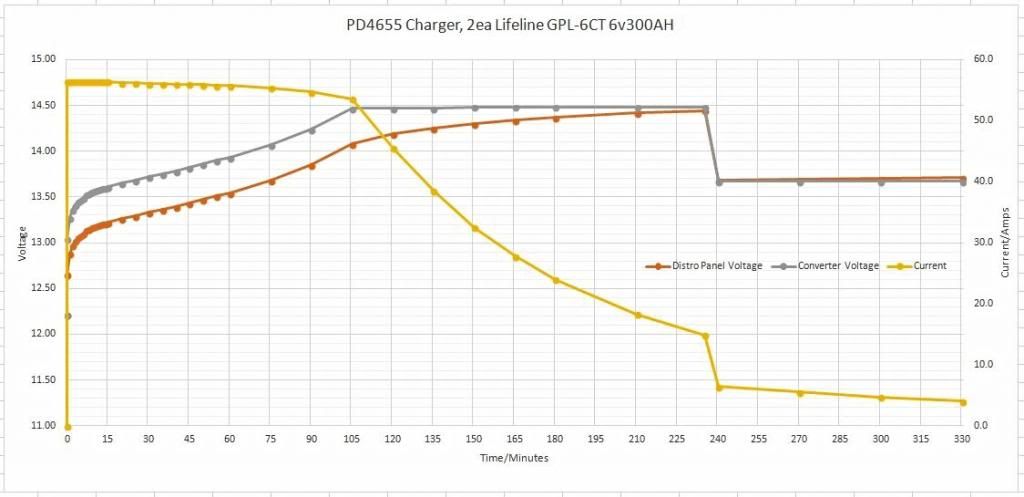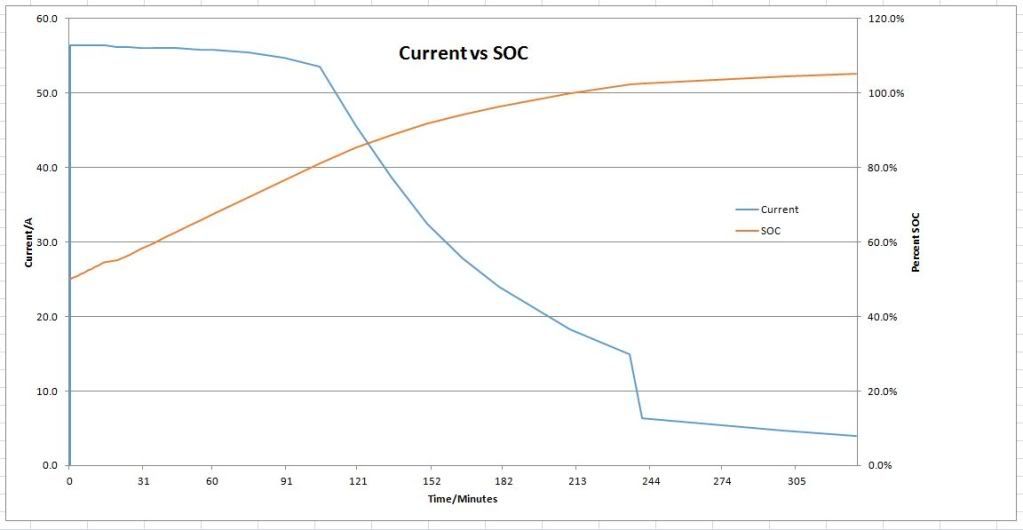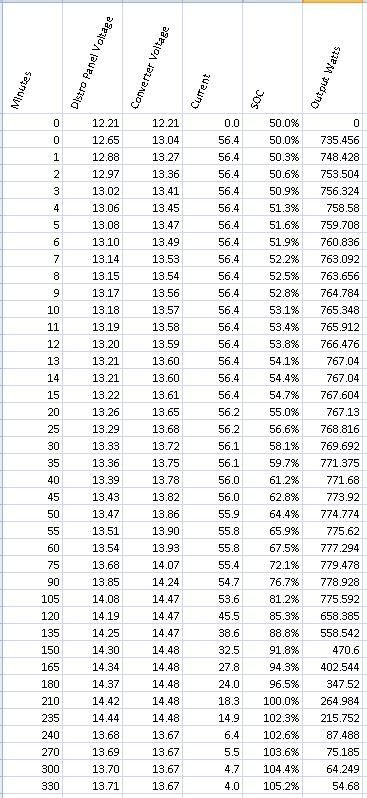- Replies 2
- Views 2.8k
- Created
- Last Reply
Top Posters In This Topic
-
Mopar1973Man 1 post
-
AH64ID 1 post
A better way to browse. Learn more.
A full-screen app on your home screen with push notifications, badges and more.
I have been reading quite a bit about different converters and charge rates, specifically some claims that PD's seem to drop off earlier than other brands. That is not what I have noticed on my setup, so I figured I would test mine from 50% SOC and take some notes.



The batteries are a pair of Lifeline AGM GPL-6CT 300AH 6V's, which where new this spring.
The converter is a Progressive Dynamics PD4655 that was new in 2013.
I got the batteries drained down to an approx 50% SOC (12.21V after sitting disconnected for ~1 hour).
I was plugged into a 30A RV circuit on my house, with an input AC voltage of 118.2±0.5V thru-out the test.
I took readings every 1 minute for the first 15 minutes, then every 5 for the first hour, then every 15 thru 3 hours, and finally 30 minute readings until 5.5 hours.
The voltage at the converter was taken where the leads are soldered into the board with a handheld fluke.
The battery voltage was taken by the lead that feeds my Blue Sea voltmeter off of the distribution panel. I want to rewire the sample location to the lug on the battery box, but I haven't yet. It's less than 3' of wire from the box to the distro panel.
My ammeter is also a Blue Sea model.
I feel there is adequate wiring, the converter came with 10ga leads soldered to the board which are approx 10" long. From the board the positive side has ~18" of 6ga to the battery switch, then approx 18" of 2ga to the batteries. The negative side also has ~18" of 6ga to the neg bus bar, then ~10" of 6ga to the shunt, and then ~18" of 2ga to the batteries. The batteries are connected with a 6" section of 1ga.
I stated the test and began recording data. I didn't realize it for the first 6 minutes but the converter was not in "boost" mode. I gained around 0.6A by going into boost mode. I was current limited at that point still so the difference didn't amount to much in the total charge time.
I don't have a way to calculate amp hours in/out of the batteries but I did a linear calculation based on the amp hours. So over a 15 minute sample if the starting charge rate was 38.6A and the ending charge rate was 32.5A the average was 35.55A meaning that approx 8.9A where put into the batteries over that 15 minutes. It's not the most accurate, but better than nothing and probably pretty close. I used that to estimate the SOC, key word is estimate.
This first graph is the voltages and current. As you can see it holds a constant 56.4A for the first 15 minutes, but then only tapers down to 54.7A on the sample just before the converter voltage hitting the 14.47 set point at 90 minutes (the measured set point for my specific PD4655).
This graph shows the charge rate versus estimated SOC. You will noticed that the estimated SOC goes above 100%, this is based on my calculated SOC.
This is the sample data.
I am estimating 50-90 time at 2.5 hours.
I didn't include the data from the 10 hour mark, but at 10 hours the voltage was 13.75 and current had dropped to 1.4A. According to Lifeline the batteries are fully charged when the current drops below 0.5A per 100AH, or 1.5A for these. On long camping trips a 10 hour generator run every few charges will be required.
Based on the large capacity of the batteries the PD held full amperage for quite a while, but even on smaller or non-AGM batteries I feel it would have held full amperage until the voltage on the circuit board was 14.47. This is where wiring is crucial.